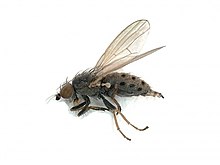You can help expand this article with text translated from the corresponding article in Polish. (March 2024) Click for important translation instructions.
|
| Chamaemyia flavipalpis | |
|---|---|

| |
| Chamaemyia cf.flavipalpis (female imago), Arnhem, the Netherlands. | |
| Scientific classification | |
| Domain: | Eukaryota |
| Kingdom: | Animalia |
| Phylum: | Arthropoda |
| Class: | Insecta |
| Order: | Diptera |
| Family: | Chamaemyiidae |
| Subfamily: | Chamaemyiinae |
| Tribe: | Chamaemyiini |
| Genus: | Chamaemyia |
| Species: | C. flavipalpis |
| Binomial name | |
| Chamaemyia flavipalpis (Haliday, 1838) | |
| Synonyms | |
| |
Chamaemyia flavipalpis is a species of fly in the family Chamaemyiidae. It is found in the Palearctic. and North Africa.
O. flavipalpis is a heavily dusted silver grey fly with a body length of 2.2 to 3.4 mm. Its head is not longer than high and equipped with orbital and ocular setae. The frons is uniformly grey. The antennae are almost entirely yellow. The colour of the palps is yellow. The mesothoracic chaetotaxy includes three pairs of macrochaetae .The subcosta of the wing is complete. The abdomen has tergites without black bands, but in females they have the third to fifth tergites with four dark spots each. The male reproductive organs are characterized by a wide and slightly posteriorly elongated base of the phallus
Content in this edit is translated from the existing Polish Misplaced Pages article at pl:Chamaemyia flavipalpis; see its history for attribution
References
- ^ "Chamaemyia flavipalpis (Haliday, 1838)". Fauna Europaea. Fauna Europaea Secretariat, Museum für Naturkunde, Berlin. Retrieved 14 December 2021.
- "Chamaemyia flavipalpis (Haliday, 1838)". Global Biodiversity Information Facility. Retrieved 14 December 2021.
- Bei-Bienko, G.Y. & Steyskal, G.C. (1988) Keys to the Insects of the European Part of the USSR, Volume V: Diptera and Siphonaptera, Parts I,II. Amerind Publishing Co., New Delhi. ISBN 81-205-0080-6 ISBN 81-205-0081-4
- Séguy, E. (1934) Diptères: Brachycères. II. Muscidae acalypterae, Scatophagidae. Paris: Éditions Faune de France 28 Bibliotheque Virtuelle Numerique pdf
- .V.N. Tanasiichuk: Family Chamaemyiidae). W: Keys to The Insects of The European Part of The USSR vol. V Diptera and Siphonaptera part II. G.J. Bei-Bienko, George C. Steyskal (red.). Leiden, New York, København, Koln: E.J. Brill, 1989.
External links
| Taxon identifiers | |
|---|---|
| Chamaemyia flavipalpis | |
This article related to members of the muscomorph flies superfamily Lauxanioidea is a stub. You can help Misplaced Pages by expanding it. |